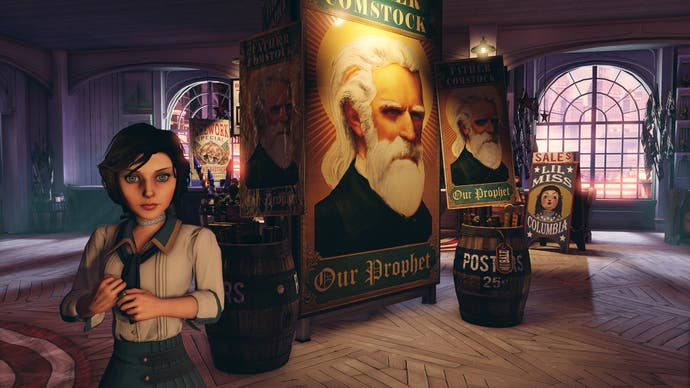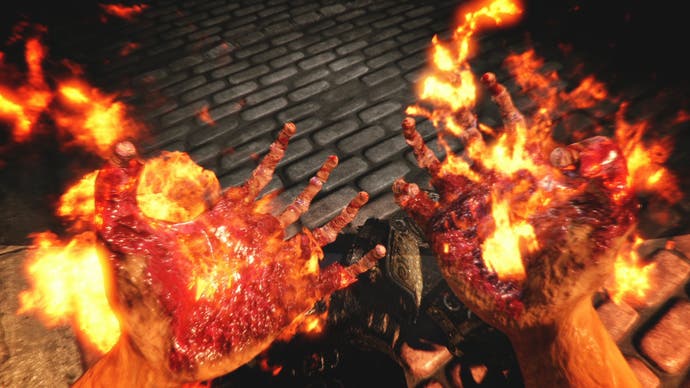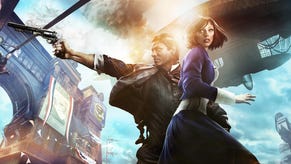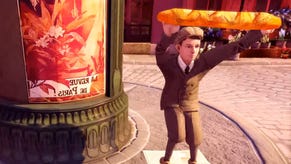BioShock Infinite preview: back on track?
Irrational breaks cover and lets us spend several hours playing with Booker and Elizabeth.
It's not common for a triple-A game to go a year and a half without appearing at a trade show or releasing any new information, but that's what BioShock Infinite has just done. After a stellar showing last spring, Irrational went dark on its highly anticipated spiritual successor to one of this generation's most acclaimed new properties. Some high-level staff left, others were recruited onto the project, and the game's now being pushed back an additional four weeks. Creative lead Ken Levine has even said that the studio was exploring multiplayer possibilities before ultimately deciding to focus all its efforts towards single-player, which may have contributed to the continued hold-up and lack of communication.
Irrational's quietness has bred suspicion, but speaking to Levine at this week's BioShock Infinite hands-on event in LA, he claims the silence was down to something else.
"The reason there's little news about the game is because we really felt we showed what the game was at E3 last year," he says. "It was very, very representative of what our vision for the game was. We didn't see a point in constantly going out and sort of beating the same drum, because what were we going to say at that point, besides, 'Here, play it'? I didn't want to go into weapon types and here's this and here's that."
Regarding the delays and staff departures, Levine notes, "It was nothing particularly dramatic," and a five-month delay since the original October 2012 target was not particularly egregious, and was perhaps exaggerated by the game being announced all the way back in 2010. As for Rod Fergusson being parachuted in from Epic Games, “If you have the opportunity to hire Rod Fergusson, you hired Rod Fergusson.”
Whether you buy all that or not (and you can read more of Levine's explanations - including stuff on the abandoned multiplayer portion of the game - in a separate interview at a later date), BioShock Infinite is definitely a video game that exists, because I've played it. It begins with an homage to 2007's BioShock that is too cute by half.
The first BioShock began on a plane with your mysterious protagonist opening a briefcase with a gun. The next thing we knew the plane went down and we were off for a swim to a nearby lighthouse. This latest BioShock adventure begins with player-character Booker Dewitt on a boat where he's given a box with a gun and is also headed towards a lighthouse. Arriving at the illuminated structure you even go into a pod again, only this time instead of a bathysphere that descends deep into the murky waters it's a rocket that takes you up, up and away to a floating city in the clouds.

Where Rapture looked oppressive and grim along the subterranean seafloor, BioShock Infinite' Columbia is so bright, majestic and ethereal that it looks like heaven as recreated by the set designers of Boardwalk Empire. There's even a gargantuan monolith of an angel that rivals the Statue of Liberty in scope, and the landing pad is called New Eden. This docking bay/cathedral is quite a sight with its thousands of candles illuminating cavernous rooms and a floor covered in a two-inch layer of sparkly clean water. The religious fervour goes beyond the architecture, too - you actually have to be baptised in order to gain entry to the city.
Instead of Andrew Ryan extolling the virtues of objectivism, this time we have the white-haired, bearded Comstock running the isolated, cultist town. Columbia's foyer is heavily adorned with ideological propaganda, like a banner that reads, "And the prophet shall lead the people to the new Eden," above a picture of townsfolk worshiping Comstock. Familiar stuff from Irrational, you might say, although since we're so starved of this kind of stuff in between BioShock games it seems slightly churlish to complain.
Besides, there are a few differences. For one thing, Booker Dewitt doesn't have amnesia - in fact he has a firm identity, even if we're only discovering it piecemeal through monochrome flashbacks. We know he's a former Pinkerton agent and his debt is so great that if he doesn't rescue his target - a girl with mysterious powers named Elizabeth - he will be killed.
Perhaps the biggest difference between Infinite and previous BioShock, at least initially, is just how lively Columbia is. Instead of taking place after the fall of an audacious, snobbish society, Infinite transpires during the heyday of one. Gone are the dead, corroded remnants of Rapture and in its place we have the the effervescent, colourful Columbia - all boardwalks, billboards, penny arcades, creameries, carnivals, flags and fairgrounds. In this respect Columbia stands apart not only from earlier BioShocks, but all other shooters on the market today. Even the similarly steampunk Dishonored was set in a grey, diseased burg, but this is a world so sparkling that one of my first thoughts upon arrival was where to buy sunscreen.
Of course this outlandish monument of merriness is only a surface-level facade to hide the this society's terrifying cultural systems. You get your first glimpse of this during a relaxing stroll through a fairground, where you can get a taste for the local flavour by playing a variety of carnival games, often themed around shooting the devil or rebel insurgents. In a slick nod to Shirley Jackson, Booker wins a lottery. His prize; he gets to be the first to throw a baseball at a captive couple consisting of an Irish man and his black wife. "I'm the one you want, not her!" the man pleads as the crowd cheers for their impending torture.

I was having none of that and attempted to throw the ball at the sadistic showman, but before I could launch it a man grabbed my hand. He had noticed the letters AD branded onto the back of it, and I had noticed several posters here and there stating that this was the mark of the false prophet who will lead all those in Comstock's flock astray. Why does Booker have these letters burned onto his hand? Who knows, but it's another noticeable throwback to the first BioShock, where the player character had mysterious chain tattoos on his wrist. Naturally, all hell breaks loose and seemingly the entire town is out for Booker's blood.
This is a very dark game in a very bright world. The lottery scene may have been shocking, but it was no match for a later set-piece on board a zeppelin involving a young Comstock devotee, which is so unsettling that I'll probably leave it for you to judge when you play it.
While the setting is incredible, one gets the sense that Infinite sticks a little too close to the BioShock template in ways that don't always work in its favour. In the previous BioShock games you were struggling for survival in mutant-infested ruins, so it made sense to dig through rubbish bins and loot people's abandoned abodes. Columbia is still functioning - even if it is in the midst of class warfare - so this typical video game behaviour of barging into people's homes and stealing all their stuff feels at odds with the setting. An hour later a tutorial message pops up warning me that there will be consequences for stealing - or getting caught, anyway - but in my experience you're able to snatch everything that isn't nailed down and nobody gives a damn. Never mind the utter ridiculousness of people keeping hot dogs in their drawer or tossing out perfectly good ammo, but these are common video game concessions that merely stick out more in a world that's otherwise so convincing.
"Let's not kid ourselves, games have a lot of ridiculous components," Levine says when I mention this to him. "You play a game like Uncharted - or this game - and the amount of mayhem caused by the characters in these games would put them up with the Hitlers of the universe... Movies do the same thing. Movies are ridiculous. Like Indiana Jones. How many people did he kill? He's this charming rogue, but he killed like 70 people. Do you really go home thinking about the 70 widows he left behind?
"I will accept certain things in gaming. I will accept looting a garbage can, but I won't accept Elizabeth doing something out of character," he adds. At least he has his priorities straight.
Beyond simply being silly, this obsessive loot-mongering bogs down the pacing of the game for people like me who strive to click on everything. Most of what you find doesn't amount to a can of beans anyway (unless it is actually a can of beans) so it seems like this scavenging aspect could use tighter editing. Infinite also brings back audio diaries, presented almost exactly as they were in the first BioShock. While Infinite relies on these less than Irrational's last big game, they're still there and still feel like lazy exposition dumps. What was novel in 2007 has since become cliche.

What most lives under the yoke of BioShock is the combat. BioShock may have been a great game, but its shooting mechanics were always a little ropey, and the early hours of Infinite do little to improve upon that. The enemy AI is irritatingly precise, so after opening fire upon an enemy everyone will know exactly where you are and there aren't any options for stealth or avoidance as far as I can tell.
Your tonics (i.e. special abilities) mostly have direct correlations to plasmids in BioShock, too. One shoots fire, another electricity; another sends numerous flying creatures to distract and damage enemies (this time crows instead of bees). They even come with funny little cartoons portraying their use, just like the first BioShock. They're presented in a different order this time around, and indeed the first one you get allows you to turn turrets on your enemies, but these are doled out at such a slow pace that the series' open-ended combat is curiously lacking from these opening hours.
The opening act also doesn't really know what to do with Booker when he has no one to play off of, so he ends up reiterating things we can already see. It feels like pandering when he says things like “they were watching her...” when he discovers a one-way mirror into Elizabeth's chamber, even though he just watched voyeuristic research footage of her.
Most of this is forgotten upon meeting Elizabeth, however. She's initially suspicious of Booker, as one would be if a man unceremoniously fell into your study from the ceiling, so she tries to beat him up with a book. Once their little meet cute is over and she understands that she's actually going outside (gasp), she gets positively giddy. That is until the songbird, her robotic protector and captor, shows up, and she becomes positively terrified instead. I, however, am positively thrilled. The escape from her crumbling, angel-shaped tower may be scripted and linear, but by golly if it isn't among the most riveting scenes I've ever experienced in a game. I don't want to spoil it, but it involves death-defying leaps, zipping around on rails, a flying mechanical bird, and a pretty girl whose awe and wonder at the world renews my own enthusiasm after Booker's nonchalant reaction to Columbia. During this moment all my criticisms melt away as I go along for the ride.
The game borrows a tactic from Uncharted by following its most exciting moments with its quietest After the bombastic escape you get to merely chill out with Elizabeth on the beach for a bit and watch her buoyant reaction to being free. You even get to decide which necklace centrepiece she buys; a bird or a cage. I'm not sure what if any consequence this has beyond her actual wardrobe being slightly altered, but it's nice to make a choice that isn't as black and white as just killing a Little Sister or not.
Aside from giving the game a heart, something missing from BioShock (but regained in BioShock 2's Minerva's Den DLC), Elizabeth's presence opens up several new combat possibilities. She can manifest different planes of reality in what she calls “tears”. Throughout the game you'll see ghostly outlines of objects that she can will into existence. The first time you can use this it's on a battlefield where you choose to summon either a machine-gun turret surrounded by barriers, or various grapple points offering access to balconies above. These can be switched at any time by looking at the transparent object you want and tapping a button. The only rule is you can only summon one tear at a time.

Elizabeth can also take care of herself in combat. She'll frequently grab items for you - represented by an icon over her head - and tapping a context-sensitive prompt results in her tossing said item towards you. More than once she saved my bacon by supplying me with a health pack or ammo right when I needed it.
Later on I'm given access to a secret late-game demo where the combat possibilities open up drastically. In the earlier sections of the game players zipped around on metal rails called skylines, but these were mostly used for traversal between combat. In the late-game demo they are incorporated far more in the thick of battle. As I'm pursued by a mechanical gorilla-like foe called the Handyman I have to constantly jump around and swing across the map on these as the beast can close great distance with a single leap. He can also electrocute the skyline railing if you hang about on it for too long.
I also get to make much more effective use of tears, with opportunities to create a decoy, health items, ammo and a turret. My tonic repertoire is spruced up in this demo, too. One new ability allows me either to blow enemies back or yank them towards me, while another warps me great distances, a la Dishonored's blink. The smooth traversal and expanded combat options really made this battle pop in a way the early hours only hinted at.
The plot also kicks up into high gear once Elizabeth is introduced. We saw in a previous demo that she could manifest a modern-day city street with a movie theatre showing "Revenge of the Jedi". In this near-final version this scene occurs earlier as Booker is observing her from a research facility looking into her chamber. Curiously, the theatre's marquee now reads "La Revanche Jedi" and Elizabeth mentions an interest in Paris. Elsewhere, old timely covers of modern songs like Girls Just Wanna Have Fun creep onto the soundtrack. What exactly is going on here?
"I try to stay away from story-related questions," Levine says. "I'll just say there's not a lot of accidents.” At this stage, it feels as though BioShock Infinite is at its best when it distinguishes itself from its predecessors - when you're bantering with Elizabeth, riding the skylines, opening up tears, nearly gunning down someone only to realise that they mean you no harm, or simply soaking up its dixieland paradise of straw hats and salt water taffy. It holds onto the series' less flattering traditions like an old pair of underwear, and the new stuff is introduced at a glacial pace, but its story, characters, and especially the setting, are a bold step forward for both Irrational and triple-A shooters on the whole.
If the worst thing I can say about it is that it feels too much like BioShock at times, well, there are worse criticisms one could level at a game.
This article is based on a press trip to Los Angeles. 2K Games paid for travel (from Portland, Oregon) and accommodation.









